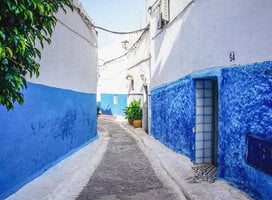Study Abroad Programs in Madagascar
Adrift in the Indian Ocean off the coast of East Africa, Madagascar -- also known as the Red Island -- is a unique crossroads between Asia and Africa and a fascinating destination, both culturally and naturally, to study abroad.
Although technically a part of Africa, Madagascar's official language, Malagasy, is linguistically an Austronesian language; resembling more closely languages spoken in Indonesia and Hawaii than mainland Africa. Each region within Madagascar has its own distinct culture, vibe, and lifestyle, but throughout the country students will discover a unique blend of African and Asian culture, with a hint of influence from French colonialists and Norwegian missionaries.
Of course, the natural features of Madagascar -- from miniature chameleons and lemurs to vast rock forests (called tsingy forests) and baobab trees -- are also a huge draw for students; especially those interested in studying the environment.
Whichever program you choose to use to study abroad in Madagascar, get ready for a beautiful, rough-and-tumble, and rice-filled adventure!
It’s important to choose a study abroad program that is perfect for you! Each one offers different opportunities - here are some things to consider before you choose your program:
Academic Life
Before choosing your program, consider what your academic interests are and what you’re hoping to get out of your study abroad experience. If you are interested in science and the environment, Madagascar has many resources for students in these areas and this may impact which program you choose. Madagascar is also a great choice for students studying sociology, history, government, and geography.
Language
Malagasy (and its many dialects) is spoken across the island. French is the official language of Madagascar and is used in academic settings, so this is a great destination for students who speak French but are looking for a more exotic study abroad locale than Europe.
Unlike other Francophone nations though, French isn't quite as widely spoken in Madagascar. You'll be able to get around, but having some knowledge of Malagasy is extremely helpful. Some basics to get you started:
- Salama - Each region has it's own greeting, but "salama!" is one of the more universally understood. Manahoana is the official dialect's way of saying hello.
- Misoatra - Thanks!
- Veloma - Bye!
- Vahaza - The term Malagasy use to say "foreigner". It's not offensive or malicious, but expect to have it shouted at you a few times...
- Mahay! - Mahay loosely translates to "to know". If you say something in Malagasy and someone replies with "Mahay!" it means they're impressed that you know some Malagasy.
- Vary - Rice.
- Loaka - The thing you eat with rice. This can refer to any of the dishes served along with rice.
Housing
Most students studying in Madagascar living in homestays with families in the city or village of their program. This is a fantastic opportunity because it allows for complete immersion in the Malagasy lifestyle and culture.
In most major cities, you can expect to have running water and electricity, though power outages are frequent. Pack a flashlight.
Antananarivo (Tana)
The capital and largest city of Madagascar, is also home to its largest universities. The city is filled with open-air markets that display beautiful homemade crafts and there are many restaurants serving traditional Malagasy food, which has influences from Asian, African, and Indian cuisine.
However, it's also large, chaotic, and certain areas have a pretty bad rap for pickpockets. Leave your valuables at home and avoid using expensive items in public (like phones or cameras) while in Tana.
Toamasina (aka Tamatave)
Located on the east coast of the island, Tamatave houses the main port of Madagascar. This destination features beautiful beaches outside of the city, and serves as a launching point for travelers going to Ile Saint Marie or Ful-point. However, it's not the safest city in Madagascar -- at least after dark -- and it's rare that you'll actually be based in the city itself.
Antsirabe
Just a few hours south of Antananarivo, Antsirabe is a cool, pleasant city located in the highlands of Madagascar and often described as a miniature version of Tana. It's home to much of the country’s farming and factories and known for its natural thermal spas and a nearby volcanic lake. Antsirabe is an excellent base for students, as it's centrally located enough for travel, has the same access to amenities and goods as Antananarivo, though much smaller, navigable, and very, very safe.
Ifaty
This area in the southwest corner of Madagascar is home to two small beach villages. A 60-mile-long coral reef right off shore creates the perfect barrier against rough waves, forming a bay that is ideal for snorkeling and fishing.
Isalo National Park
This park is a great destination for nature lovers. It is filled with natural wonders and a great variety of terrains, including grasslands and sandstone canyons.
Ile Sainte Marie
This island off the coast of Madagascar, this small and idyllic island is the perfect place to relax, enjoy the beach, snorkel, and watch the many humpback whales that live in the area. Catch bus-boat combos from Tamatave to get there, or fly from Tana.
Scholarships for studying abroad in Madagascar
- SIT offers scholarships to students participating in their programs (and they have three in Madagascar!).
- More Study Abroad Grants and Scholarships






























